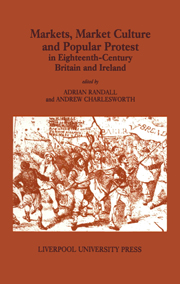Book contents
- Frontmatter
- Contents
- Contributors
- Preface
- 1 Markets, Market Culture and Popular Protest in Eighteenth-Century Britain and Ireland
- 2 Popular Protest and the Persistence of Customary Corn Measures: Resistance to the Winchester Bushel in the English West
- 3 The Jack-a-Lent Riots and Opposition to Turnpikes in the Bristol Region in 1749
- 4 The Cider Tax, Popular Symbolism and Opposition in Mid-Hanoverian England
- 5 Scarcity and the Civic Tradition: Market Management in Bristol, 1709–1815
- 6 The Moral Economy of the English Middling Sort in the Eighteenth Century: the Case of Norwich in 1766 and 1767
- 7 Oxford Food Riots: a Community and its Markets
- 8 The Irish Famine of 1799–1801: Market Culture, Moral Economies and Social Protest
- Index
2 - Popular Protest and the Persistence of Customary Corn Measures: Resistance to the Winchester Bushel in the English West
- Frontmatter
- Contents
- Contributors
- Preface
- 1 Markets, Market Culture and Popular Protest in Eighteenth-Century Britain and Ireland
- 2 Popular Protest and the Persistence of Customary Corn Measures: Resistance to the Winchester Bushel in the English West
- 3 The Jack-a-Lent Riots and Opposition to Turnpikes in the Bristol Region in 1749
- 4 The Cider Tax, Popular Symbolism and Opposition in Mid-Hanoverian England
- 5 Scarcity and the Civic Tradition: Market Management in Bristol, 1709–1815
- 6 The Moral Economy of the English Middling Sort in the Eighteenth Century: the Case of Norwich in 1766 and 1767
- 7 Oxford Food Riots: a Community and its Markets
- 8 The Irish Famine of 1799–1801: Market Culture, Moral Economies and Social Protest
- Index
Summary
Pre-nineteenth-century British systems of weights and measures are notoriously complicated and difficult for the modern observer to understand. As is well known, a profusion of apparently quaint and archaic weights and measures were to be found in use in the market place and farmyard into the eighteenth century and beyond. Thus, there were windles, rods, ells, elns, lagens, firkins, kilderkins, tuns, terses, pottles, poles and perch. One could have a bolt of oziers, a curnock of barley, a firlot of beer, a hobbit of wheat or a poke of wool. This abundance of frequently unrelated measures continues to bequeath problems to the modern historian from the pioneer quantifiers in economic history to the present-day cliometricians. They create major difficulties of comparability which hinder our understanding of prices and quantities. They raise questions as to how transactions were managed in the market place. Further, their survival contrasts strongly with the notion that during the eighteenth century there was a clear and sustained development of a national market in commodities, particularly in grain. Hence, much of the recent writing on the issue places emphasis upon the success of the campaign to standardize weights and measures which came increasingly to fruition at the end of the eighteenth and early nineteenth centuries. In these accounts, metrological reformers, informed by the ‘quantifying spirit’ of the Enlightenment (an impetus to quantify, measure, categorize and order the earth and its products), are portrayed as part and parcel of a process of modernization, driven on the one hand by the force of developing commerce and on the other by the enlightened gentlemen who ran the country.
- Type
- Chapter
- Information
- Publisher: Liverpool University PressPrint publication year: 1996
- 1
- Cited by



